Allentown, Pennsylvania Blood Testing Facilities
 Represents a LabCorp blood testing facility
Represents a LabCorp blood testing facility Represents a Quest Diagnostics blood testing facility
Represents a Quest Diagnostics blood testing facility

Nearby Labcorp Blood Testing facilities:
- Labcorp Center Distance: 4 m, 1362 Catasaqua Rd, Bethlehem, Lehigh County, PA, 18017
- Labcorp Center Distance: 12 m, 3729 Easton Nazareth Hwy 102, Easton, Northampton County, PA, 18045
- Labcorp Center Distance: 13 m, 680 N West End Blvd, Quakertown, Bucks County, PA, 18951
- Labcorp Center Distance: 14 m, 446 Pottstown Ave, Pennsburg, Montgomery County, PA, 18073
- Labcorp Center Distance: 17 m, 411 Coventry Center Dr Bldg400, Phillipsburg, Warren County, NJ, 8865
- Labcorp Center Distance: 20 m, 173 Holly Road Suite 100, Gilbertsville, Montgomery County, PA, 19525
- Labcorp Center Distance: 22 m, 102 Memorial Road, Schwenksville, Montgomery County, PA, 19473
- Labcorp Center Distance: 24 m, 1456 Ferry Rd Ste 702, Doylestown, Bucks County, PA, 18901
- Labcorp Center Distance: 25 m, 1690 Sumneytown Pike Ste 100, Lansdale, Montgomery County, PA, 19446
- Labcorp Center Distance: 26 m, 649 N Lewis Road Suite 1000, Royersford, Montgomery County, PA, 19468
- Labcorp Center Distance: 27 m, 1001 S Broad St Blg C Ste 1050, Lansdale, Montgomery County, PA, 19446
- Labcorp Center Distance: 28 m, 534 2Nd Avenue Suite 104, Collegeville, Montgomery County, PA, 19426
- Labcorp Center Distance: 29 m, 1432 Easton Road Suite 1F, Warrington, Bucks County, PA, 18976
- Labcorp Center Distance: 30 m, 100 Eaglesmere Cir 200C, East Stroudsburg, Monroe County, PA, 18301
- Labcorp Center Distance: 32 m, 342 W Germantown Pike Ste 330, East Norriton, Montgomery County, PA, 19403
- Labcorp Center Distance: 33 m, 1330 Powell St Ste 603, Norristown, Montgomery County, PA, 19401
- Labcorp Center Distance: 34 m, 832 West Germantown Pike 4, Plymouth Meeting, Montgomery County, PA, 19462
- Labcorp Center Distance: 35 m, 150 Allendale Rd Ste 1120, King Of Prussia, Montgomery County, PA, 19406
- Labcorp Center Distance: 37 m, 254 B Mountain Ave Ste 104, Hackettstown, Warren County, NJ, 7840
- Labcorp Center Distance: 38 m, 1140 Old York Road, Abington, Montgomery County, PA, 19001
- Labcorp Center Distance: 39 m, 80 W Welsh Pool Rd Ste 100, Exton, Chester County, PA, 19341
- Labcorp Center Distance: 40 m, 15200 Bustleton Ave Unit C, Philadelphia, Philadelphia County, PA, 19116
- Labcorp Center Distance: 41 m, 157 W Lancaster Ave Ste 167, Ardmore, Montgomery County, PA, 19003
- Labcorp Center Distance: 42 m, 9815 Roosevelt Blvd Unit F, Philadelphia, Philadelphia County, PA, 19114
- Labcorp Center Distance: 43 m, 2 Bala Plaza Ste Il-21, Bala Cynwyd, Other, PA, 19004
- Labcorp Center Distance: 44 m, 5349 Oxford Ave Unit B, Philadelphia, Philadelphia County, PA, 19124
- Labcorp Center Distance: 45 m, 5 Monroe St Bldg 1 Ste E, Bridgewater, Somerset County, NJ, 8807
- Labcorp Center Distance: 46 m, 66 Town Centre Suite 310, Succasunna, Other, NJ, 7876
- Labcorp Center Distance: 47 m, 40 Morristown Rd Ste 2A, Bernardsville, Somerset County, NJ, 7924
- Labcorp Center Distance: 48 m, 10 Forrestal Road South, Princeton, Middlesex County, NJ, 8540
- Labcorp Center Distance: 49 m, 1703 South Broad Street 200, Philadelphia, Philadelphia County, PA, 19148
- Labcorp Center Distance: 50 m, 227 Newton Sparta Rd Ste 8, Newton, Sussex County, NJ, 7860
- Labcorp Center Distance: 51 m, 775 Mountain Blvd. Ste 102, Watchung, Somerset County, NJ, 7069
- Labcorp Center Distance: 52 m, 400 Old Forge Lane Ste A1, Kennett Square, Chester County, PA, 19348
- Labcorp Center Distance: 53 m, 1601 N Kings Hwy Ste 100, Cherry Hill, Camden County, NJ, 8034
- Labcorp Center Distance: 54 m, 1592 Route 739, Dingmans Ferry, Pike County, PA, 18328
- Labcorp Center Distance: 55 m, 358 Hamlin Hwy Bldg 2, Hamlin, Wayne County, PA, 18427
- Labcorp Center Distance: 56 m, 2123 Concord Pike, Wilmington, New Castle County, DE, 19803
- Labcorp Center Distance: 57 m, 313 South Ave Ste 104, Fanwood, Union County, NJ, 7023
- Labcorp Center Distance: 58 m, 42 E Laurel Rd-Rowen Bldg 1500, Stratford, Other, NJ, 8084
- Labcorp Center Distance: 60 m, 2701 Kirkwood Hwy, Wilmington, New Castle County, DE, 19805
- Labcorp Center Distance: 61 m, Viking Village Rt 94 Bldg 3 A, Vernon, Sussex County, NJ, 7462
- Labcorp Center Distance: 62 m, 2333 Morris Ave Ste A12, Union, Union County, NJ, 7083
- Labcorp Center Distance: 63 m, 212 Cherry Ln, New Castle, New Castle County, DE, 19720
- Labcorp Center Distance: 64 m, 390 N Broadway Ste 1000, Pennsville, Salem County, NJ, 8070
- Labcorp Center Distance: 65 m, 314 E Main St Ste 105, Newark, New Castle County, DE, 19711
- Labcorp Center Distance: 66 m, 102 East Ave, Woodstown, Salem County, NJ, 8098
- Labcorp Center Distance: 67 m, 393 Central Avenue, Newark, Essex County, NJ, 7103
- Labcorp Center Distance: 68 m, 2031 Forest Ave Stes 12 13, Staten Island, Richmond County, NY, 10303
- Labcorp Center Distance: 69 m, 240 Port Richmond Ave, Staten Island, Richmond County, NY, 10302
- Labcorp Center Distance: 70 m, 31 New Dorp Ln, Staten Island, Richmond County, NY, 10306
Nearby Quest Blood Testing facilities:
- Quest Center Distance: 1 m, 1608 W Allen St, Allentown, Lehigh County, PA, 18102-2012
- Quest Center Distance: 3 m, 1251 S Cedar Crest Blvd, Allentown, Lehigh County, PA, 18103-6205
- Quest Center Distance: 4 m, 111 E Harrison St, Emmaus, Lehigh County, PA, 18049-2916
- Quest Center Distance: 7 m, The Shoppes At Hellertown, Hellertown, Northampton County, PA, 18055-1360
- Quest Center Distance: 9 m, 4333 Easton Ave, Bethlehem, Northampton County, PA, 18020-1431
- Quest Center Distance: 12 m, 3601 Nazareth Rd, Easton, Northampton County, PA, 18045-8336
- Quest Center Distance: 13 m, 229 S 22Nd St, Easton, Northampton County, PA, 18042-3810
- Quest Center Distance: 18 m, 541 Constitution Ave, Perkasie, Bucks County, PA, 18944-1248
- Quest Center Distance: 20 m, 1050 E Philadelphia Ave, Gilbertsville, Montgomery County, PA, 19525-9517
- Quest Center Distance: 21 m, 708 Route 113, Souderton, Bucks County, PA, 18964-1004
- Quest Center Distance: 22 m, 418 Blue Valley Drive, Bangor, Northampton County, PA, 18013-2561
- Quest Center Distance: 23 m, 345 Main Street, Harleysville, Montgomery County, PA, 19438-0000
- Quest Center Distance: 25 m, 252 W Swamp Rd, Doylestown, Bucks County, PA, 18901-2408
- Quest Center Distance: 26 m, 223 Shoemaker Rd, Pottstown, Montgomery County, PA, 19464-6433
- Quest Center Distance: 27 m, 545 S Broad St, Lansdale, Montgomery County, PA, 19446-3701
- Quest Center Distance: 28 m, 130 W Main St, Trappe, Montgomery County, PA, 19426-2025
- Quest Center Distance: 29 m, 4400 Perkiomen Ave, Reading, Berks County, PA, 19606-3920
- Quest Center Distance: 30 m, 408 Lincoln Ave, East Stroudsburg, Monroe County, PA, 18301-2893
- Quest Center Distance: 32 m, 400 Cresson Blvd, Phoenixville, Montgomery County, PA, 19460-6127
- Quest Center Distance: 33 m, 720--730 E Johnson Highway, Norristown, Montgomery County, PA, 19401-3110
- Quest Center Distance: 34 m, 200 Lakeside Dr, Horsham, Montgomery County, PA, 19044-2321
- Quest Center Distance: 35 m, 491 Allendale Rd, King Of Prussia, Montgomery County, PA, 19406-1430
- Quest Center Distance: 36 m, 1866 Bethlehem Pike, Flourtown, Montgomery County, PA, 19031-1504
- Quest Center Distance: 37 m, 137 Mountain Ave, Hackettstown, Warren County, NJ, 07840-2307
- Quest Center Distance: 38 m, 1419 Old York Rd, Abington, Montgomery County, PA, 19001-2710
- Quest Center Distance: 39 m, 636 Old York Road, Jenkintown, Montgomery County, PA, 19046-2857
- Quest Center Distance: 40 m, 2221 West Market Street, Pottsville, Schuylkill County, PA, 17901-1806
- Quest Center Distance: 41 m, 525 Jamestown Street, Philadelphia, Philadelphia County, PA, 19128-1751
- Quest Center Distance: 42 m, 9808 Bustleton Avenue, Philadelphia, Philadelphia County, PA, 19115-2190
- Quest Center Distance: 43 m, 5675 N Front St, Philadelphia, Philadelphia County, PA, 19120-0000
- Quest Center Distance: 44 m, 4022 Woodhaven Rd, Philadelphia, Philadelphia County, PA, 19154-2810
- Quest Center Distance: 45 m, 400 W Allegheny Ave, Philadelphia, Philadelphia County, PA, 19133-3639
- Quest Center Distance: 46 m, 153 Levittown Pkwy, Levittown, Bucks County, PA, 19055-2465
- Quest Center Distance: 47 m, 1 Anderson Hill Rd, Bernardsville, Somerset County, NJ, 07924-2320
- Quest Center Distance: 48 m, 601 W Union Ave, Bound Brook, Somerset County, NJ, 08805-1166
- Quest Center Distance: 49 m, 125 Newton Sparta Rd, Newton, Sussex County, NJ, 07860-2812
- Quest Center Distance: 50 m, 330 W. Oregon Avenue, Philadelphia, Philadelphia County, PA, 19148-4723
- Quest Center Distance: 51 m, 37 Mountain Blvd, Warren, Somerset County, NJ, 07059-2622
- Quest Center Distance: 52 m, 402 Mcfarlan Rd, Kennett Square, Chester County, PA, 19348-2453
- Quest Center Distance: 53 m, 24 Stelton Rd, Piscataway, Middlesex County, NJ, 08854-2639
- Quest Center Distance: 54 m, 2700 Silverside Rd, Wilmington, New Castle County, DE, 19810-3724
- Quest Center Distance: 55 m, 276 E Main St, Denville, Morris County, NJ, 07834-2646
- Quest Center Distance: 56 m, 904 Oak Tree Ave, South Plainfield, Middlesex County, NJ, 07080-5126
- Quest Center Distance: 57 m, 50 Cherry Hill Rd, Parsippany, Morris County, NJ, 07054-1101
- Quest Center Distance: 58 m, 189 Elm St, Westfield, Union County, NJ, 07090-3145
- Quest Center Distance: 59 m, 1020 Route 18, East Brunswick, Middlesex County, NJ, 08816-4354
- Quest Center Distance: 60 m, 956 Justison St, Wilmington, New Castle County, DE, 19801-5149
- Quest Center Distance: 61 m, 4512 Kirkwood Hwy, Wilmington, New Castle County, DE, 19808-5125
- Quest Center Distance: 62 m, 349 E Northfield Rd, Livingston, Essex County, NJ, 07039-4806
- Quest Center Distance: 63 m, 1896 Morris Ave, Union, Union County, NJ, 07083-3535
- Quest Center Distance: 64 m, 711 E 1St Ave, Roselle, Union County, NJ, 07203-1669
Pennsylvania Hormone Replacement Therapy Services
Are you over the age of thirty and feel that conditions associated with aging are dragging you down, preventing you from enjoying life the way that you should? The Conscious Evolution Institute utilizes 21st century medical technologies which have been proven to mitigate the impact of hormone imbalance and deficiency, two of the primary physiological factors which contribute to accelerated aging.
With just a simple phone call, we can arrange for you to meet with one of our affiliate physicians, located all across the state of Pennsylvania. In just a single doctor's visit, our clinical specialists will have all of the information to make an informed diagnosis on your behalf, and arrange for Quality Hormone Replacement Therapy Products to be shipped straight to your door.
Pennsylvania HGH Therapy
The Conscious Evolution Institute is highly experienced in diagnosing and treating Human Growth Hormone Deficiency, a medical condition which inhibits cellular metabolism and slows down your body's restorative and rehabilitative processes, speeding up the aging process and increasing the risk of a variety of medical conditions, as well as causing your health to simply deteriorate more quickly.
Common symptoms of HGH Deficiency include unexplained weight gain, loss of muscle mass, weakened immune system, fatigue, loss of exercise capacity, sleep disorder, and depression.
We use two primary methods to treat Human Growth Hormone Deficiency: Bio-Identical HGH Injections and Sermorelin Acetate Therapy. Both of these treatments are administered via subcutaneous injection, and both are highly effective means to restore a youthful balance of natural HGH.
Pennsylvania Andropause/Low-T Treatments
We also offer Testosterone HRT for the treatment of Andropause. Andropause is a medical condition related to Menopause which affects men as they grow older. Testosterone Production remains high from the beginning of puberty until around the age of thirty. Starting at about thirty years of age, the body starts to produce less and less Testosterone.
Symptoms of Testosterone Deficiency include: Loss of strength and muscle tone, weight gain, anxiety, osteoporosis, cardiovascular complications, elevated cholesterol levels, fatigue, loss of libido, sexual dysfunction.
Every man has their own unique needs for Testosterone, dependent upon their lifestyle, body composition, and genetic heritage. Some men are more sensitive to Low-T than others, especially men with conditions which exacerbate Age-Related Low-T, including Obesity and Diabetes. If you are experiencing sexual issues in combination with other symptoms such as those listed above, there is a significant chance that Testosterone Patches, Gels, or Injections could change your life.
Pennsylvania HCG Therapy for Weight Loss
The Conscious Evolution Institute also provides a number of other Hormone Therapy solutions, including the HCG Diet for Weight Loss. HCG is a hormone naturally produced by the human body during pregnancy, and medical research has shown that this hormone stimulates a number of processes which are highly beneficial to both women and men that are struggling to lose weight.
Normally, when engaging in sudden caloric restriction, the human body stops burning fat and starts burning muscle tissue, but HCG Injections encourage the body to continue burning fat. Also, HCG blocks the sensation of hunger caused by Ghrelin and other hunger hormones, making it easier to eat less.
HCG Injections, combined with a strict diet, encourage rapid weight loss and sustain energy, allowing patients to lose weight quickly, easily, and comfortably.
Major Cities in Pennsylvania
Philadelphia
Philadelphia, Pennsylvania is the largest city and metro in the state, and is popularly known as the City of Brotherly Love. This nickname represents the literal meaning of Philadelphia, and the motto of the city is auPhiladelphia maneto, au which means Let Brotherly Love Endure.
The most famous historical attraction of Philadelphia is the Liberty Bell, which was created in 1752, and became cracked after the first time it was tolled. Philadelphia is a major city for American professional sports, with a number of teams, including the Philadelphia Phillies of the MLB, the 76ers of the NBA, and the Eagles of the NFL.
Pittsburgh
Pittsburgh is the second most populated metro area and city in Pennsylvania, and is nicknamed The Steel City because of its central importance to the steel industry in the late 1800s and beyond. During the second World War, Pittsburgh manufactured nearly 100 million tons of steel dedicated toward the war effort. Pittsburgh's motto is auBenigno Numine, au which means auBy the favor of Heaven au in English.
Like Philadelphia, Pittsburgh also has a strong presence in professional sports, the home of the Pittsburgh Steelers of the NFL and the Pittsburgh Pirates of the MLB. The city is also home to the University of Pittsburgh, also known simply as Pitt.
Allentown
Allentown is the fourth largest city in the state of Pennsylvania, The motto of Allentown is auSic Semper Tyrannis, au meaning auThus always to Tyrants au in English. In context, the motto represents a commitment to dispel tyrants in the name of freedom. Allentown is the primary city of a region of cities known as the Lehigh Valley Region, which includes Easton, Pennsylvania and Bethlehem, Pennsylvania.
Erie
Erie, Pennsylvania is the fourth largest city in the state, and is located on the shore of Lake Erie. Erie is commonly referred to by two nicknames: The Gem City and the Flagship City. It's referred to as the Gem City because of its shining appearance from Lake Erie, and its referred to as the Flagship City because it was the home port of the Niagara Navy Flagship.
Erie was originally an important city for steel and iron manufacturing, but today, its economy relies on tourism, plastic manufacturing, environmental research, and biofuel manufacture.
Reading
Reading is the fifth largest city in the state of Pennsylvania, and is located about 60 miles from Philadelphia. Reading has the nickname The Pretzel City, stemming from the large number of pretzel bakeries in the city.
The largest employer in the city of Reading is the Reading Hospital and Medical Center, and the largest private employer is the East Penn Manufacturing Company.
All About Allentown, Pennsylvania Geographic Area
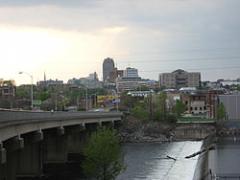

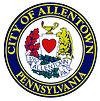
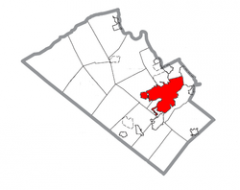
Allentown (Pennsylvania Dutch: Allenschteddel) is a city located in Lehigh County, Pennsylvania, in the United States. It is Pennsylvania's third most populous city, after Philadelphia and Pittsburgh, and the 215th largest city in the United States. As of the 2010 census, the city had a total population of 118,032 and is currently the fastest growing city in Pennsylvania. It is also the county seat of Lehigh County. In 2012, the city celebrated the 250th anniversary of its founding in 1762.
Located on the Lehigh River, Allentown is the largest of three adjacent cities that make up a region of eastern Pennsylvania and western New Jersey known as the Lehigh Valley. Allentown is 60 miles (97 km) north of Philadelphia, the fifth most populous city in the United States, 80 miles (130 km) east of Harrisburg, the state capital, and 90 miles (140 km) west of New York City, the nation's largest city.
Two four-year colleges, Cedar Crest College and Muhlenberg College, are located in Allentown. Dorney Park & Wildwater Kingdom, a very popular amusement park, is located just outside of the city.
Commercial airline service to and from the city is available through Lehigh Valley International Airport (LVIA). General aviation and charter service is offered by LVIA and Allentown Queen City Municipal Airport.
The city is connected to the Interstate Highway System by Interstate 78 and Interstate 476, the Northeast Extension of the Pennsylvania Turnpike, which provide access connections to other major Northeastern United States urban areas. Also U.S. Route 22, the Lehigh Valley Thruway, provides a limited access east-west highway connection to the Interstate Highway System to the northern parts of the city. Commuter train service between Allentown and Philadelphia ended in 1979 when state funding to operate the service ceased.
Allentown is a two-time winner of the All-America City Award, being recognized in 1962 and 1974 ae1975. Allentown was named the 12th most conservative city in America by the non-partisan Bay Area Center.
The area that is today the center of Allentown was laid out as Northampton Town in 1762 by William Allen, a wealthy shipping merchant, former mayor of the city of Philadelphia and then-Chief Justice of the Province of Pennsylvania. The property was part of a 5,000-acre (20 km2) plot Allen purchased on September 10, 1735 from his business partner Joseph Turner, who was assigned the warrant to the land by Thomas Penn, son of William Penn, on May 18, 1732. The tract was originally surveyed on November 23, 1736. A subsequent survey done in 1753 by David Schultz for a road from Easton to Reading, of which present-day Union and Jackson streets were links, shows the location of a log house owned by Allen, situated near the western bank of the Jordan Creek, which was believed to have been built around 1740. Used primarily as a hunting and fishing lodge, here Allen entertained prominent guests including his brother-in-law, James Hamilton, and colonial governor John Penn.
The original plan for the town, now in the archives of the Historical Society of Pennsylvania, comprised forty-two city blocks and consisted of 756 lots, mostly 60 feet (18 m) in width and 230 feet (70 m) in depth. The town was located between present-day Fourth and Tenth Streets, and Union and Liberty Streets. Many streets on the original plan were named for Allen's children: Margaret (present-day Fifth Street), William (now Sixth), James (now Eighth), Ann (now Ninth) and John (now Walnut). Allen Street (now Seventh) was named for Allen himself, and was the main thoroughfare. Hamilton Street was named for James Hamilton. Gordon Street was named for Sir Patrick Gordon, Deputy Governor of Colonial Pennsylvania from 1726 ae1736. Chew Street was named for Benjamin Chew, and Turner Street was named for Allen's business partner, Joseph Turner.
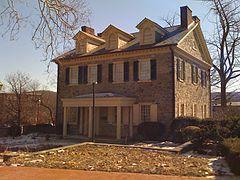
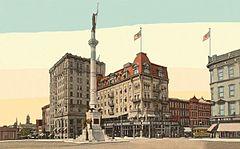
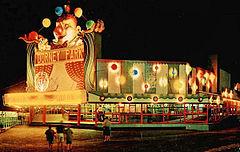
Allen hoped that Northampton Town would displace Easton as the seat of Northampton County and also become a commercial center due to its location along the Lehigh River and its proximity to Philadelphia. Allen gave the property to his son James in 1767. Three years later, in 1770, James built a summer residence, Trout Hall, in the new town, near the site of his father's former hunting lodge.
On March 18, 1811, the town was formally incorporated as the Borough of Northamptown. On March 6, 1812, Lehigh County was formed from the western half of Northampton County, and Northampton Town was selected as the county seat. The town was officially renamed "Allentown" on April 16, 1838, after years of popular usage. Allentown was formally incorporated as a city on March 12, 1867.
Allentown holds historical significance as the location where the Liberty Bell (then known as the Pennsylvania State House bell) was successfully hidden from the British during the American Revolutionary War. After George Washington's defeat at the Battle of Brandywine on September 11, 1777, the revolutionary capital of Philadelphia was defenseless, and that city prepared for British attack. The Supreme Executive Council of the Commonwealth of Pennsylvania ordered that eleven bells, including the State House bell and the bells from Philadelphia's Christ Church and St. Peter's Church, be taken down and removed from the city to prevent the British, who would melt the bells down to cast into cannons, from taking possession of them. The bells were transported north to Northampton-Towne, and hidden in the basement of the Old Zion Reformed Church, in what is now center city Allentown. Today, a shrine and museum in the church's basement, known as the Liberty Bell Museum, marks the spot where the bell was hidden.
After the Battle of Trenton on December 26, 1776, Hessian prisoners-of-war were kept in the vicinity of present-day Seventh and Gordon Streets. The Old Zion Reformed Church, and a house near James (now Eighth) and Hamilton Streets, served as hospitals for injured and sick Continental Army troops. In 1777, a factory manufacturing paper cartridges for muskets was relocated here from nearby Bethlehem. That same year, a shop of sixteen armorers was established along the Little Lehigh Creek, and employed in the repair of weapons and the manufacture of saddles and scabbards.
Prior to the 1830s, Allentown was a small town with only local markets. The arrival of the Lehigh Canal, however, expanded the city's commerce and industrial capacity greatly. With this, the town underwent significant industrialization, ultimately becoming a major center for heavy industry and manufacturing. While Allentown was not as large as neighboring Bethlehem at the time, the local iron industry ae which included the Allentown Iron Company (established 1846) and the Allentown Rolling Mills (established 1860) ae employed the majority of Allentown's workforce. Railroads, such as the Lehigh Valley Railroad, were vital to the movement of raw materials and finished goods, and employed a significant workforce during this time. This period of rapid economic growth in the region was halted by two events, the Panic of 1873 and the Long Depression.
In addition to the iron and railroad industries, Allentown also had a strong tradition in the brewing of beer and was home to several notable breweries, including the Horlacher Brewery (founded 1897, closed 1978), the Neuweiler Brewery (founded 1875, closed 1968) and Schaefer Beer, whose brewery was later owned by Pabst Brewing Company and Guinness but is now owned by the Boston Beer Company, maker of Samuel Adams.
Economic recovery in the early 20th century was brought about by the silk and textile industry. The Adelaide Silk Mill, one of the largest in the world at the time, opened in Allentown in 1881. By 1928, there were more than 140 silk and textile mills in the Lehigh Valley, making it the second largest industry in the region. By the 1930s, the silk industry was in worldwide decline, as synthetics were taking the place of silk. Catoir Silk Mill, the last silk mill in Allentown, closed in 1989. In 1905, Mack Trucks moved to Allentown, beginning Allentown's focus on heavy industrial manufacturing. Today, Allentown's economy, like most of Pennsylvania's, is based in the service industries with some manufacturing. Deindustrialization has caused many of the factories and corporations headquartered in Allentown to close or move. For example, Mack Trucks is now located in Greensboro, North Carolina, LSI Corporation (formerly Agere Systems, which merged with LSI Logic) moved its headquarters to California, and numerous factories have ceased operation. On the other hand, the Allentown Economic Development Corporation (AEDC) operates a business incubator, the Bridgeworks, which helps attract and support young commercial and manufacturing businesses.
Allentown is located at 40 °36'6" North, 75 °28'38" West (40.601697, na75.477328). According to the United States Census Bureau, the city has a total area of 18.0 square miles (46.6 km2). 17.8 square miles (46.1 km2) is land and 0.2 square miles (0.5 km2) is water. Bodies of water include the Jordan Creek and its tributary, the Little Lehigh Creek, which join within the city limits and empty into the Lehigh River. Other bodies of water within the city limits include Lake Muhlenberg in Cedar Creek Parkway and a pond in Trexler Park.
The city sits within the Lehigh Valley, a geographic region bounded by Blue Mountain, a ridge of the Appalachian mountain range, which varies from 1,000 to 1,600 feet (490 m) in height about 17 miles (27 km) north of the city, and South Mountain, a ridge of 500 to 1,000 feet (300 m) in height that borders the southern edge of the city.
The city is the county seat of Lehigh County. The adjacent counties are Carbon County to the north; Northampton County to the northeast and east; Bucks County to the southeast; Montgomery County to the south; and Berks County and Schuylkill County to the west.
Further details (including smaller communities) can be found in the location box at the bottom of this article.
Allentown's climate is considered to fall in the humid continental climate zone. Summers are typically hot and muggy, fall and spring are generally mild, and winter is cold. Precipitation is almost uniformly distributed throughout the year.
The average temperature in January is 27.1 °F ( na2.7 °C), and the lowest officially recorded temperature was na16 °F ( na27 °C) in 1912. July averages 73.3 °F (22.9 °C), and the highest temperature on record was 105 °F (41 °C) in 1966. Early fall and mid-winter are generally driest, with February being the driest month with only 2.75 inches (70 mm) of average precipitation.
Snowfall is variable, with some winters bringing light snow and others bringing numerous significant snowstorms. Average snowfall is 32.4 inches (82 cm) per year, with the months of January and February receiving the highest at just over 11 and 9 inches each. Rainfall is generally spread throughout the year, with eight to twelve wet days per month, at an average annual rate of 43.52 inches (110.54 cm).
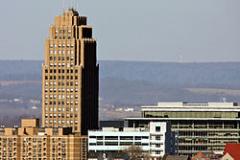
Center City, which includes the downtown area and the 7th Street retail and residential corridor, is the city's central business district and the host to various city, county and federal government centers. To the east of Center City are "The Wards," the areas that developed as residential areas during the city's industrial boom of the late 19th century and early 20th century. Just east of the Lehigh River are the city's East Side residential neighborhoods, most of which border the various routes to nearby Bethlehem. South of Center City, and across the Little Lehigh Creek, are the city's South Side neighborhoods, which border Emmaus. Lastly, there is West End Allentown, which comprises most neighborhoods west of 15th Street.
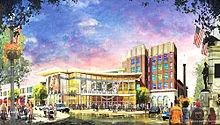
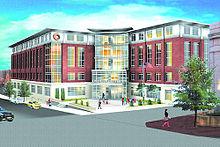
Plans for a major redevelopment of the Central Business District of Allentown were announced in late 2009 as a result of Neighborhood Improvement Zone (NIZ) legislation passed by the Pennsylvania legislature. Focused on the 7th and Hamilton Streets area, a 5-acre one square block was acquired by Eminent domain during 2011 in which several new structures are planned to be erected:
The project has generated considerable concern centered on the huge cost of the endeavor from funding a plan with no cap. The estimated cost of the project is currently at $277 million. As of October 2012, $224.3 million in bonds have been sold. In addition to the funding issues, there has been debate about the economic feasibility of the project, which is in an urban, high crime area that has limited parking available as well as the limited seating capacity of the arena. Also, concerns have arisen that the project may not generate enough revenue to cover the cost of construction, which has more than doubled from its initial estimate.
Existing structures were demolished in early 2012. However, several lawsuits were filed due to the nature of the funding of the project. The lawsuits were settled in mid-2012 and construction is now underway with an estimated 2014 completion.
Allentown's Center City neighborhoods mainly consist of a variety of Victorian and Federal rowhomes. The stately homes around West Park are mostly Victorian and Craftsman. The houses on the city's tree-lined streets in the West End were mostly built in the 1920s and 40's. Houses in the City's East Side and South Side are a mixture of architectural styles and are generally single and twin family homes built from the 1940s through the 1960s with century old Victorians in the mix. Allentown also has loft apartments in converted mills and historic brick manufacturing buildings and modern and historic high-rise apartment buildings.
The PPL Building is Allentown's tallest building at 322 feet (98 m). It is 23 stories high and is located at the northwest corner of 9th and Hamilton Street. A Lehigh Valley icon, this Art Deco tower can be seen from places throughout the Lehigh Valley; in clear weather, the tower can be seen as far north as the ski resort pass over Blue Mountain. One of the city's older still-standing structures, Allentown Symphony Hall, at 23 North Sixth Street in Center City, was constructed in 1896.
The City of Allentown is characterized by a large stock of historic homes, commercial structures and century-old industrial buildings.
There are three historic districts in Allentown, Old Allentown, the Old Fairgrounds and West Park neighborhoods. Old Allentown and Old Fairgrounds are Center City neighborhoods that hold a joint house tour organized by Old Allentown Preservation Association (OAPA) once a year in September. The West Park neighborhood also offers a tour of this district's larger Victorian and Craftsman-style homes.
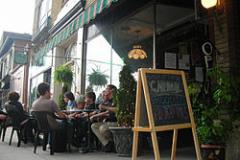
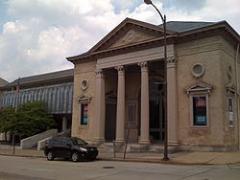
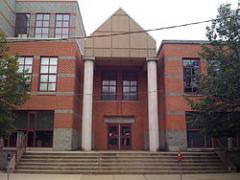
The Allentown Symphony Orchestra performs at Allentown Symphony Hall, located on North Sixth Street in center city. The city also has a musical heritage of civilian concert bands, and is home to the Allentown Band, the oldest civilian concert band in the United States. The Allentown Band, Marine Band of Allentown, Municipal Band of Allentown and the Pioneer Band of Allentown all regularly perform at the bandshell in the city's West Park.
The city houses a collection of public sculptures, including the DaVinci Horse, located on 5th Street. This sculpture is one of three in the world.
The Allentown Art Museum, located on North Fifth Street in Center City, is home to a collection of more than 13,000 pieces of art, along with an associated library. The Baum School of Art, located in downtown Allentown at 5th and Linden Streets, offers credit and non-credit classes in painting, drawing, ceramics, fashion design, jewelry making and more.
Civic Theatre of Allentown has an 80-plus year history of producing theatre in the Lehigh Valley. Started by two Morning Call reporters in 1927 as "Civic Little Theatre", the current day Civic Theatre of Allentown relies on a paid professional staff, volunteer board of directors from the community, and volunteers from the region. Civic Theatre stands on three pillars: theatre, film and education. Civic is a professionally directed, managed and run theatre that utilizes community actors in its live theatre productions. Civic also operates the Lehigh Valley aos only full-time cinema exclusively showing art, independent and foreign films and a theatre school that has been served the Valley aos youth for more than 50 years.
Vestiges of Allentown's Pennsylvania German heritage remain present in its cuisine, and foodstuffs such as scrapple, chow-chow, Lebanon bologna, cole slaw and apple butter are often found offered in local diners and the Allentown Farmer's Market. Shoofly pie, birch beer, and funnel cakes are regularly found at local fairs. Several local churches make and sell fastnachts as a fundraiser for Fastnacht Day, the day before the start of Lent.
As the population of the city has increased, many national restaurant and fast food chains have established a presence in the city. More recently, growth of the city's ethnic populations has led to the opening of many family run restaurants specializing in ethnic cuisine. Ethnic food types represented include Chinese, Colombian, Dominican, Italian, Japanese, Mexican, Lebanese, Portuguese, Puerto Rican, Thai and West Indian.
Due in part to Allentown's proximity to Philadelphia, cheesesteaks are also popular. Yocco's Hot Dogs, a regionally well-known hot dog and cheesesteak establishment with six area locations, was founded in 1922 by Theodore Iacocca, uncle of Lee Iacocca. In addition, A-Treat, a regionally-popular brand of carbonated soft drinks, has been based in Allentown since 1918.
Allentown is home to the area's premier amusement park, Dorney Park & Wildwater Kingdom.
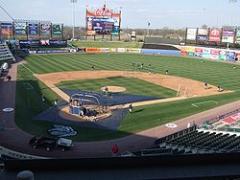
Allentown has a history in the sport of professional baseball that dates back to 1884. In 2008, Allentown unveiled Coca-Cola Park, a $50.25 million, 8,100-seat stadium. The stadium was constructed in east-side Allentown to serve as the home field for the Philadelphia Phillies' AAA-level Minor League baseball team, the Lehigh Valley IronPigs. The IronPigs, a member of the International League, are the first Major League-affiliated club to play in the city since 1960.
Allentown hosted the Allentown Jets, an Eastern Professional Basketball League team, from 1958 to 1981. The Jets were one of the most dominant franchises in the league's history, winning eight playoff championships and twelve division titles. The team aos home games were played in Rockne Hall at Allentown Central Catholic High School.
Parkettes National Gymnastics Training Center, which has been the training ground for numerous Olympians and U.S. national gymnastics champions, is based in Allentown. In 2003, CNN aired a documentary on Parkettes, Achieving the Perfect 10, which depicted it as a hugely demanding and competitive training program.
In March 2011, plans were announced for the creation of Allentown Arena, an 8,500-seat arena to be built in Allentown which is planned to be the future home for the Adirondack Phantoms, the American Hockey League affiliate of the Philadelphia Flyers. The arena may be located in downtown Allentown taking up the entire block between 7th and 8th Streets and Hamilton and Linden Streets. In a controversial decision, the city has invoked eminent domain to help obtain the necessary properties and a contractor is expected to be chosen in 2012. In January 2012, buildings on the current site began to be demolished to make room for the new arena. Construction on the site, however, is at a standstill pending litigation on the legality of the financing of the Arena, putting the future of the entire project in doubt.
Allentown is also home to the Stoners, a professional soccer team. From 1979 ae1983, the Stoners were members of the American Soccer League. The team had a five-year league record of 76 ae49 ae25, and won the league championship in 1980. Due to increasing competition from other soccer leagues, and decreasing attendance, the team folded in 1983. The team was resurrected in 2007 as the Pennsylvania Stoners, and competes in the National Premier Soccer League (NPSL). Based in Allentown, the team originally played its home games at J. Birney Crum Stadium. In 2008, the team captured the NPSL league championship. Since 2009, the Stoners play their home games at Whitehall-Coplay School District's Zephyr Sports Complex in nearby Whitehall. The Easton-based Northampton Laurels FC, of the Women's Premier Soccer League, also play at J. Birney Crum Stadium.
Word Count: 4204





